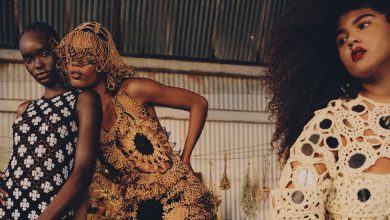The Strange Effects of Putting an Ordinary Woman Into Glamorous Images

The woman in one video emerges from a Rolls-Royce wearing nothing but underwear and sunglasses, her arm draped across her bare chest. In another image, a woman in a green bikini and thigh-high patent-leather boots clutches a wall as if suddenly realizing she’s had one too many. A video features a couple of Kardashian-Jenners palpating a wall illuminated by blinking neon tube lights. A woman straddles her open hatchback while wrapped in string.
People have spent a very long time attacking these types of glamorous images for being unrealistic — for altering, enhancing and modifying everything down to the models’ physiology. But a photo comparison showing how the subject’s waist was artificially cinched still works from the assumption that these images are trying to get away with subtly misrepresenting the real world. For years, the Australian comedian and actress Celeste Barber has focused on something different: Rather than show how these lavishly stylized images distort reality, she shows how crazy it is to think they’re depicting any kind of reality, any realm of normal human behavior, at all.
She does this by guilelessly emulating the images around her, as though she fails to perceive their strangeness, as though they were the most natural thing in the world. In the version of that Kardashian video Barber posted to Instagram, she feels her way around a hallway in a skintight jumpsuit as someone flicks the lights awkwardly on and off. In her take on a video of Britney Spears writhing beside the ocean in a bikini, Barber ends up tossed around by waves. She posts a video of Gwyneth Paltrow waking up “glowy,” thanks to her skin-care routine, then one of herself waking up in yesterday’s makeup. Barber looks ridiculous — not because she is failing to live up to an image, but because it is so ludicrous to even try. Her persona is that of an ordinary woman with no internalized shame about failing to satisfy an artificial beauty standard — someone who sees a gorgeous woman in a bikini and boots clutching a wall and simply decides to try it for herself.
This shtick, which Barber calls “Challenge Accepted,” began in 2015 “as a fun experiment to see what it would look like for an average person to photograph herself doing rich-people things.” Six years later, it has spawned a book and a stand-up show. Barber has 8.4 million followers on Instagram and has won a Webby award, presented by Naomi Watts, who praised Barber for her empowering self-love. This might seem a funny thing to say about a woman who is constantly flailing around in bikinis trying to look as unsexy as possible. But it makes some sense in the context of Instagram, where it’s not uncommon to see a gorgeous woman post a photo of herself without makeup, revealing the vaguest hint of a roll of fat, followed by a multiparagraph essay on how important it is to own one’s imperfections — an obvious humblebrag. Barber, though, revels in her realness. The more bizarre, awkward or hilarious she makes herself look, the better she comes off. It’s always the original image that ends up seeming ridiculous and grotesque, not her.
In her book “The End of Love,” an analysis of how avoiding love has become a hallmark of contemporary relationships, the sociologist Eva Illouz writes that “the economic valuation of the female body was made possible by the fact that it was transformed into a tradable visual unit.” In the 20th century, she argues, sexual-liberation movements were subsumed into the consumer economy, and “new norms of attractiveness” — a “mixture of clothing styles, allure and bodily shape” — were codified into images that could be circulated with a value of their own, one independent of the identity or status of the women pictured.
Social media has only normalized making a commodity-spectacle of oneself, dutifully reproducing “sexiness,” which Illouz defines as “the result of new ideologies of sexuality as a commodity form and of the self as image.” Young people, especially young women, have a breezy facility with creating highly artificial images of themselves for online consumption, posing and lighting themselves as if advertising something — and, often, happily self-objectifying, enjoying the satisfactions of making their lives, and themselves, look like luxury items.
Barber’s Instagram account began as a catalog of Barber trying to do “rich-people things,” but in fact these kinds of images are meant not only for rich people. They are intended to transcend class — not only to reposition luxury goods as consumer items everyone might aspire to have, but to position women, or a very narrow subset of women, as a stand-in for the idea of women in the marketplace. Each represents a fantastical feminine ideal and its punishing relationship to the world. Perhaps it would be more accurate to think of Barber’s project as a catalog of “capitalist things,” or “lady things,” or a combination of both — the bourgeois “lady” being, after all, the human embodiment of capitalism.
In her “Challenge Accepted” comedy show, Barber observes that “in the land of being a lady, it seems that if you look a certain way — if you are really tall, a bird, and slim, you know, all arms and legs; think praying mantis, if you will” — if you are “an excellent, gorgeous praying-mantis woman, and you want to post naked photos of yourself, you, my friend, you are empowering. That is empowering to women. Thank you. Now if you are not so praying mantis, and a little more armadillo, and you also want to post naked photos of yourself — not empowering to women. It is, however, very brave” — the implication being that, in this context, “brave” is code for “fat.”
Barber isn’t fat, though she does play up the ways in which her body fails to conform to “the look”; this is how she reveals its oppressive primacy, and the fact that buying things cannot turn you into the person modeling them. Is it “brave” for her to display her body emerging unclad from a car (not a Rolls-Royce), or writhing on the sand in a bikini, or imitating a French dancer by hanging from her hair in a garage in her undergarments? Is it merely brave to do so while looking like a person who does not have the B.M.I. of a pencil? Is it brave simply to not be hot enough to shut down the critical faculties that lead you to notice that what she is doing is dumb and unnatural and hilarious, and that there might be something very wrong with us that we find it so persuasive?
A decade ago, it seemed like a common joke involved women being self-effacing about not living up to these images of glamour, casting their ordinariness as a kind of relatable failure. Barber’s dutiful re-enactments feel so cathartic because she has found a simple, elegant way to turn that joke around. She does not scan as a person failing to live up to a look. You’re moved instead to think about the image itself. What is it supposed to communicate? What is it supposed to sell? Why do we engage with it as if it has so much relevance to the real world? Why weren’t we laughing before?
Source photographs: Screen grabs from Instagram.
Carina Chocano is the author of the essay collection “You Play the Girl” and a contributing writer for the magazine. She last wrote about a cat charging into a baseball game.





